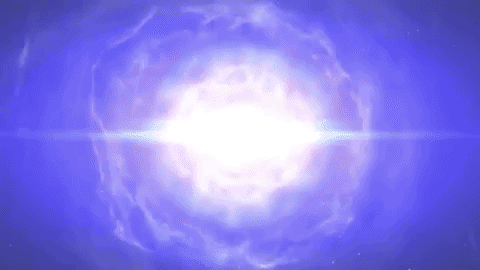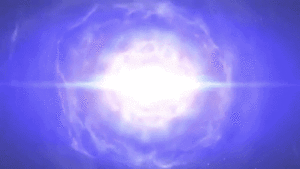Neutron stars are created when giant stars die in supernovae and their cores collapse, with the protons and electrons essentially melting into each other to form neutrons. Neutron stars are city-size stellar objects with a mass about 1.4 times that of the sun. Born from the explosive death of another, larger stars, these tiny objects pack quite a punch.
When stars three times as massive as the sun explodes in a violent supernova, their outer layers can blow off in an often-spectacular display, leaving behind a small, dense core that continues to collapse. Gravity presses the material in on itself so tightly that protons and electrons combine to make neutrons, yielding the name “neutron star.” This is how it is named neutron star.
Ordinary stars maintain their spherical shape because they have the gravity of their gigantic mass tries to pull their gas toward a central point, but it is balanced by the energy from nuclear fusion in their cores, which exerts an outward pressure. At the end of their lives, when stars are burned through their available fuel, their internal fusion reactions cease. The stars’ outer layers rapidly collapse inward, bouncing off the thick core and then blasting out again as a violent supernova.
After the star went supernova the dense core continues to collapse, generating pressures so high that protons and electrons are squeezed together into neutrons, as well as lightweight particles called neutrinos that escape into the distant universe. The end result is a star whose mass is 90% neutrons, which can’t be squeezed any tighter, and therefore the neutron star can’t break down any further.
Neutron stars pack their mass inside a 20-kilometre (12.4 miles) diameter. They are so dense that a single teaspoon would weigh a billion tons — assuming you somehow managed to snag a sample without being captured by the body’s strong gravitational pull. On average, gravity on a neutron star is 2 billion times stronger than gravity on Earth. In fact, it’s strong enough to significantly bend radiation from the star in a process known as gravitational lensing, allowing astronomers to see some of the backsides of the star.
The power from the supernova that birthed it gives the star an extremely quick rotation, causing it to spin several times in a second. Neutron stars can spin as fast as 43,000 times per minute, gradually slowing over time.
The properties of neutron stars are utterly out of this world — a single teaspoon of neutron-star material would weigh a billion tons. If you were to somehow stand on their surface without dying, you’d experience a force of gravity 2 billion times stronger than what you feel on Earth.
An ordinary neutron star’s magnetic field might be trillions of times stronger than Earth’s. But some neutron stars have even more extreme magnetic fields, a thousand or more times the average neutron star. This creates an object known as a magnetar.
Starquakes on the surface of a magnetar — the equivalent of crustal movements on Earth that generate earthquakes — can release tremendous amounts of energy. In one-tenth of a second, a magnetar might produce more energy than the sun has emitted in the last 100,000 years.
Astronomers first theorized about the existence of these bizarre stellar entities in the 1930s, shortly after the neutron was discovered. But it wasn’t until 1967 that scientists had good evidence for neutron stars in reality. A graduate student named Jocelyn Bell at the University of Cambridge in England noticed strange pulses in her radio telescope, arriving so regularly that at first, she thought they might be a signal from an alien civilization, according to the American Physical Society. The patterns turned out not to be E.T. but rather radiation emitted by rapidly spinning neutron stars.
If a neutron star is part of a binary system that survived the deadly blast from its supernova (or if it captured a passing companion), things can get even more interesting. If the second star is less massive than the sun, it pulls mass from its companion into a Roche lobe, a balloon-like cloud of material that orbits the neutron star. Companion stars up to 10 times the sun’s mass create similar mass transfers that are more unstable and don’t last as long.
Stars more than 10 times as massive as the sun transfer material in the form of a stellar wind. The material flows along the magnetic poles of the neutron star, creating X-ray pulsations as it is heated.
By 2010, approximately 1,800 pulsars had been identified through radio detection, with another 70 found by gamma-rays. Some pulsars even have planets orbiting them — and some may turn into planets.
Types of neutron stars
Radio pulsars
Recycled pulsars
Millisecond pulsars
Magnetar
Soft gamma-ray repeater
Anomalous X-ray pulsar
Low-mass X-ray binaries (LMXB)
Intermediate-mass X-ray binaries (IMXB)
High-mass X-ray binaries (HMXB)
Accretion powered pulsar
Pulsars
Some neutron stars have jets of materials streaming out of them at nearly the speed of light. As these beams pan past Earth, they flash like the bulb of a lighthouse. Scientists called them pulsars after their pulsing appearance. Normal pulsars spin between 0.1 and 60 times per second, while millisecond pulsars can result in as much as 700 times per second.
When X-ray pulsars capture the material flowing from more massive companions, that material interacts with the magnetic field to produce high-powered beams that can be seen in the radio, optical, X-ray or gamma-ray spectrum. Because their main power source comes from the material from their companion, they are often called “accretion-powered pulsars.” “Spin-powered pulsars” are driven by the star’s rotation, as high-energy electrons interact with the pulsar’s magnetic field above their poles. Young neutron stars before they cool can also produce pulses of X-rays when some parts are hotter than others.
As material within a pulsar accelerates within the magnetosphere of a pulsar, the neutron star produces gamma-ray emission. The transfer of energy in these gamma-ray pulsars slows the spin of the star.
The supernova that gives rise to a neutron star imparts a great deal of energy to the compact object, causing it to rotate on its axis between 0.1 and 60 times per second, and up to 700 times per second. The formidable magnetic fields of these entities produce high-powered columns of radiation, which can sweep past the Earth-like lighthouse beams, creating what’s known as a pulsar.
The flickering of pulsars is so predictable that researchers are considering using them for spaceflight navigation.
“Some of these millisecond pulsars are extremely regular, clock-like regular,” Keith Gendreau of NASA’s Goddard Space Flight Center in Maryland, told members of the press in 2018.
“We use these pulsars the same way we use the atomic clocks in a GPS navigation system,” Gendreau said.
Magnetars
The average neutron star boasts a powerful magnetic field. Earth’s magnetic field is around 1 gauss, and the sun’s magnetic field is around a few hundred gauss, according to astrophysicist Paul Sutter. But a neutron star has a trillion-gauss magnetic field.
Magnetars have magnetic fields a thousand times stronger than the average neutron star. The resulting drag causes the star to take longer to rotate.
“That puts magnetars in the No. 1 spot, reigning champions in the universal ‘strongest magnetic field’ competition,” Sutter said. “The numbers are there, but it’s hard to wrap our brains around them.”
These fields wreak havoc on their local environments, with atoms stretching into pencil-thin rods near magnetars. The dense stars can also drive bursts of high-intensity radiation.
Get too close to one (say, within 1,000 kilometres, or about 600 miles), and the magnetic fields are strong enough to upset not just your bioelectricity (rendering your nerve impulses hilariously useless) but your very molecular structure. In a magnetar’s field, you just kind of dissolve.”
Collision Of Neutron Star
Like normal stars, two neutron stars can orbit one another. If they are close enough, they can even spiral inwards to their doom in an intense phenomenon known as a “kilonova.”
The collision of two neutron stars made waves heard ’round the world in 2017 when researchers detected gravitational waves and light coming from the same cosmic smashup. The research also provided the first solid evidence that neutron-star collisions are the source of much of the universe’s gold, platinum and other heavy elements.
“The origin of the really heaviest chemical elements in the universe has baffled the scientific community for quite a long time,” Hans-Thomas Janka, a senior scientist at MPA, said in a statement. “Now, we have the first observational proof for neutron star mergers as sources; in fact, they could well be the main source of the r-process elements,” which are elements heavier than iron, like gold and platinum.
The powerful collision released enormous amounts of light and created gravitational waves that rippled through the universe. But what happened to the two objects after their smashup remains a mystery.
“We don’t actually know what happened to the objects at the end,” David Shoemaker, a senior research scientist at MIT and a spokesman for the LIGO Scientific Collaboration, said at a 2017 news conference. “We don’t know whether it’s a black hole, a neutron star or something else.” The observations are thought to be the first of many to come.
“We expect that more neutron-star mergers will soon be observed and that the observational data from these events will reveal more about the internal structure of matter,” study lead author Andreas Bauswein, from the Heidelberg Institute for Theoretical Studies in Germany, said in a statement.
Can Neutron Star Become Blackhole?
When a star dies, it spent all of its energy and then collapses. Their difference lies in their parent star. When a dying star has a mass which is 1.4 to 3 times that of the sun, it will form a neutron star. Stars with a mass greater than 3 times the sun’s mass, a black hole is formed. The maximum mass of a neutron star is 3 solar masses. If it gets more massive than that, then it will collapse into a quark star, and then into a black hole.
Some Interesting Fact
1. In just the first few seconds after a star begins its transformation into a neutron star, the energy leaving in neutrinos is equal to the total amount of light emitted by all of the stars in the observable universe.
2. It’s been speculated that if there were life on neutron stars, it would be two-dimensional.
3. The fastest known spinning neutron star rotates about 700 times each second.
4. The wrong kind of neutron star could wreak havoc on Earth.
5. Despite the extremes of neutron stars, researchers still have ways to study them.
Researchers have considered using the stable, clock-like pulses of neutron stars to aid in spacecraft navigation, much like GPS beams help guide people on Earth. An experiment on the International Space Station called Station Explorer for X-ray Timing and Navigation Technology (SEXTANT) was able to use the signal from pulsars to calculate the ISS’s location to within 10 miles (16 km).
But a great deal remains to be understood about neutron stars. For instance, in 2019, astronomers spotted the most massive neutron star ever seen — with about 2.14 times the mass of our sun packed into a sphere most likely around 12.4 miles (20 km) across. At this size, the object is just at the limit where it should have collapsed into a black hole, so researchers are examining it closely to better understand the odd physics potentially at work holding it up.

